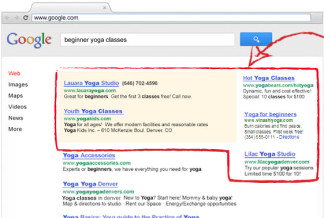
1. Include the search phrase in the headline
The #1 rule to attract attention with pay-per-click advertising is to repeat the searcher’s exact terms in the headline. The search engines even bold those terms in the ad text.
“Dynamic keyword insertion” automates the process. If one of the keywords in your Candy group of keywords is “lollipops”, you add a bit of coding for your Google AdWords headline like this: “Buy {keyword:Candy} Online”. When a user searches for “lollipops”, Google will display your headline as “Buy Lollipops Online”.
2. Pitch a unique (or at least different from competitors) selling proposition
The problem with #1 rules is that everybody tends to follow them, resulting in a lineup like this one, with three me-too ads and one 
Google AdWords authority Perry Marshall names six unique selling propositions you might try:
- You’re unique because of the buyer you serve (“Meet Over-50 Singles”).
- You’re unique because of what you sell.
- You’re unique because you have an unusual angle (“Auto Hail Damage Repair – 30% Off Your Insurance Estimate”).
- You’re unique because of what your product or service does not do (“Freeze Away Your Fat. No Surgery At All. No Downtime!”)
- You’re unique because of the time frame around your offer.
- You’re unique because of how you guarantee your product.
Search engine marketing expert David Rodnitzky suggests aiming your ads at the emotions, like these imaginary headlines for an exercise bike text ad:
- Fear: “Embarrassed, Out of Shape?”
- Greed: “80% Off Exercise Bikes”
- Vanity: “Look Like a Supermodel”
- Exclusivity: “World’s Best Exercise Bike”
Whatever approach you take, successful selling propositions are:
- Specific
- Bold
- Aimed squarely at the customer’s needs
- Limited to one per ad
- Fulfilled by what’s offered on the landing page linked from the ad
3. Grab attention with symbols and numbers in headlines and copy
Numbers and symbols (the ones you can make with your keyboard) are eye-catching and space saving. Searchers may interpret the trademark, service mark, and registered mark as signs of stability in a business. Dollar amounts, of course, play to the greed motivation of ad clickers to find a deal. Just look at how much Logobench squeezed into its ad: $69 for 5 designs from 3 designers in 48 hours. That’s pretty much all you need to know to want to click.

4. Push the boundaries with the display url and sitelinks
Take advantage on Google AdWords of two opportunities to present more messages beyond the allotted space for headline and ad copy. You can make the display url for your landing page read however you like after your domain name. Dr. Zwiebel introduced the “tummy tuck” concept and his name without taking up space for it elsewhere. You can add “sitelinks” to your AdWords ad, deep links to pages on your site, and use the link text to present more offers; see how the Santa Monica plumber offered a compelling “Thursday – Tech Ready Now” message with a sitelink.

5. Make a call to action!
Talk about the power of suggestion: Tests have shown that if you add “Call Now!” or “Order Now!” to your PPC text ad that folks are actually more likely to do it.

The Guide to Winning
More Business Online
We’ll show you how to land more customers with a better website and online presence in this free ebook.





